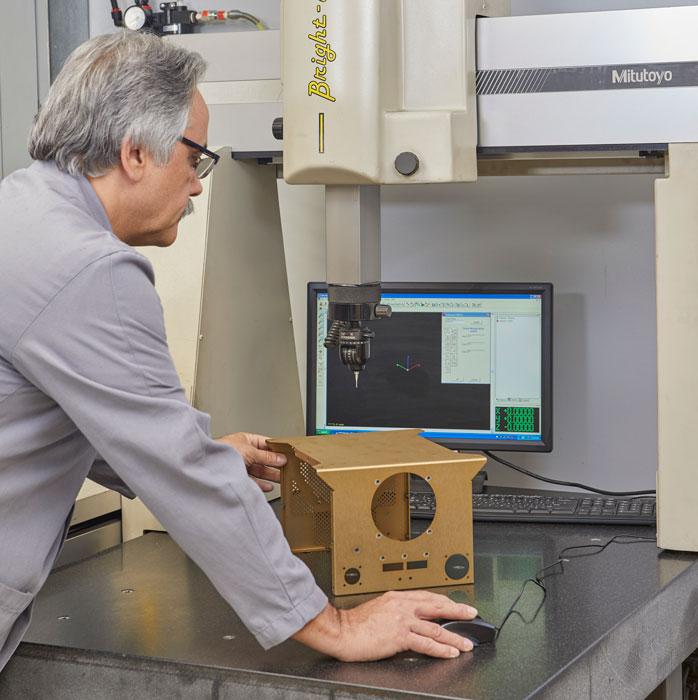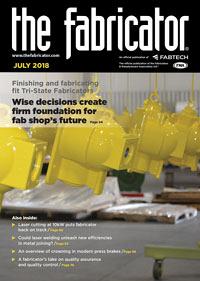Manager, Corporate Quality Assurance
- FMA
- The Fabricator
- FABTECH
- Canadian Metalworking
Categories
- Additive Manufacturing
- Aluminum Welding
- Arc Welding
- Assembly and Joining
- Automation and Robotics
- Bending and Forming
- Consumables
- Cutting and Weld Prep
- Electric Vehicles
- En Español
- Finishing
- Hydroforming
- Laser Cutting
- Laser Welding
- Machining
- Manufacturing Software
- Materials Handling
- Metals/Materials
- Oxyfuel Cutting
- Plasma Cutting
- Power Tools
- Punching and Other Holemaking
- Roll Forming
- Safety
- Sawing
- Shearing
- Shop Management
- Testing and Measuring
- Tube and Pipe Fabrication
- Tube and Pipe Production
- Waterjet Cutting
Industry Directory
Webcasts
Podcasts
FAB 40
Advertise
Subscribe
Account Login
Search
The difference between quality assurance and quality control
They focus on different areas of the value chain, but both are needed to keep customers happy
- By Dipak Gandhi and Shannon Eggleton
- July 13, 2018
- Article
- Shop Management

Figure 1
Quality assurance team members stay on top of daily production efforts. Dashboards that bring together information such as rework rates for certain manufacturing processes are helpful tools in this task.
If you Google “QA vs. QC,” it returns approximately 47.9 million results. While that’s only slightly more than half the number of search results as “Taylor Swift” produces, it illustrates how much confusion exists around the differences between quality assurance (QA)and quality control (QC).
While not every company defines QA and QC in the exact same way and the departments and areas might overlap in some manufacturing facilities, QA and QC do share some commonalities in the way they are treated in metal fabrication environments.
At EVS Metal, Riverdale, N.J., the role of QA is more about quality planning and ensuring potential quality issues are prevented, rather than just correcting problems that have already occurred. Of course, when quality issues do arise, quality personnel implement corrective action as well.
QA specialists also review customer returns and handle internal rejections, all with an eye toward continuous improvement and achieving the goals set up in the quality management system (QMS). The quality assurance team also works with vendors on quality-related issues, so they are able to make improvements.
On the other hand, the role of QC is skewed more toward the back end of the fabrication process, including in-process inspections, final inspections, receiving inspections, calibration, and first-article inspections.
In other words, QA is more about prevention, while QC focuses more on post-fabrication inspection and remediation when necessary. Both are important and are concerned with quality, but they have sharply different focuses and immediate objectives.
How Do QA and QC Roles Differ?
The QA role at EVS Metal requires juggling a lot of different details and objectives, depending on what projects are going through the QA process at any given time. This means that no two days are exactly alike. One day might involve reviewing sales orders for new parts before releasing them to the shop floor as per the new product checklist; handling reviews of customer returns or rejections; or analyzing internal rejections and disposition of rejections with the materials review board.
The next day might necessitate the initiation of corrective and preventive actions as required on a customer return or because of an internal rejection; coordinating quality-related issues with customers and vendors; or reviewing the performance of the QMS to make any changes that may be needed to achieve goals.
The QC team’s daily responsibilities are no less complex. They may spend an entire day performing first-/last-piece approval for each order during each stage of fabrication and finishing; a morning receiving inspections for purchased items; an afternoon calibrating measuring equipment; or most of a day handling final inspection of a product before it’s released for shipment.
QA is involved with a job from the very start. Modern manufacturing projects require QA standards be built directly into design plans from the beginning. The EVS Metal QA team is involved with the fabrication process from the job’s kickoff, working alongside the engineering team to ensure design-for-manufacturability factors are considered upfront at the same time that customer specifications and other project requirements are being reviewed. QA assists in determining the many criteria necessary for efficient, cost-effective, and quality fabrication. This can include the design of manufacturing sequences, definition of critical dimensions at the component level, review of jig requirements during spot welding, and welding process and postmortem after first-build to address issues or make changes.

Figure 2
Quality control plays a huge part in ensuring quality goals are achieved with each production order. A check of part dimensions on a coordinate measuring machine is one way they do just that.
In other words, QA is involved at just about every stage of fabrication, from product design to the setup of job processes to the management of production flow (see Figure 1). QC then takes over, ensuring all of the final measurements meet the specs set out at the beginning (see Figure 2).
QA + QC: The Dream Team
One example of how a QA team tackles complex projects was demonstrated when EVS Metal received an unusually challenging request from a medical equipment manufacturer almost two years ago.
The request for proposal involved the fabrication of an elaborate chassis that required more than 30 sheet metal parts riveted together. It also required more than 600 incidences of manually inserted hardware pieces and rivets, all with extremely tight tolerances because of the end-use application. Now, this will probably come as a complete shock to anyone reading this, but it turned out that a number of the tolerances specified on the drawings were beyond the capability of typical fabrication processes. (Pause for shocked silence.)
Luckily, the QA team knew exactly how to respond. They took the time necessary at the start of the project to grasp the most critical features of the chassis. This was an essential first step. Why? As it turns out, the aspects of the chassis that required the tolerances that were outside of normal fabrication capabilities would need to be reverse-engineered. To do that, the team had to understand exactly what the chassis was supposed to do and how it was supposed to function in the first place.
Because of the QA department’s dedication to address the customer’s needs in parallel with the project’s challenges, it found a way to make the design work. With assistance from the engineering, sales, and production teams, QA took advantage of tolerances for functional requirements while implementing various controls to be used during manufacturing. While the design of the parts did ultimately change to allow the tolerances required to be achieved, each adjustment was small enough as to not be easily noticed in the final assembly.
By keeping a close eye on the manufacturing process stipulated by QA from the start of fabrication to final inspection, the QC team ensured the final product met the customer’s requirements. This prevented any issues during the on-site integration and ultimately made for one happy customer (not to mention a loyal one too).
In fact, EVS Metal’s QA and QC departments were able to achieve a 5.5 sigma level for defect per million opportunities (DPMO). They also managed fewer than 1 percent of customer returns for operator-related error and fewer than 0.2 percent scrap of completed assembly. This entire project illustrated why a rock-solid quality team is an irreplaceable asset for a metal fabricator.
Challenges, Continuous mprovement, and the Future of Quality
With more than 100 years of combined experience in the fabrication and machining job sectors, EVS Metal has plenty of skill depth in its current quality team. However, that doesn’t mean that the team isn’t constantly kept on its toes by both customers and industry trends.
For instance, customer requirements for cosmetic finishes generally are not well-documented when they are handed over to quality. In fact, most customers’ drawings are generated with software that assigns ±0.005-in. tolerances on all features.
So when ± 0.005-in. tolerances across the board aren’t feasible for the price a customer is able to pay, EVS Metal still works to find creative ways to make that customer’s fabrication dreams come true. The company’s quality team takes into account bottom-line job requirements and expectations, so they are able to mark up internal documents and make design changes that allow the customer to get its expected tolerances without the additional cost.
In terms of the industry overall, however, one of the biggest challenges the company’s quality team faces is change. It’s absolutely a constant, and keeping up with the latest trends can be a job in and of itself. Whether playing a part in instituting new applications of Six Sigma and lean methodologies, tracking regulatory updates, or analyzing a QMS for additional potential efficiencies across business processes, continuous improvement simply never ends.
QA and QC may not be the same, but both play very important parts in the most central issue of maintaining overall product quality. From design to deployment, a quality team ensures that every job meets the requirements set out at each stage of the manufacturing process, so that the end result is the same every time—products that meet, if not exceed, customer expectations, each and every time.
Dipak Gandhi is manager, corporate quality assurance, and Shannon Eggleton is marketing and communications manager, EVS Metal, 1 Kenner Court, Riverdale, NJ 07457, 888-938-7638, www.evsmetal.com.
About the Authors
Shannon Eggleton
Marketing and Communications Manager
888-938-7638
Related Companies
subscribe now

The Fabricator is North America's leading magazine for the metal forming and fabricating industry. The magazine delivers the news, technical articles, and case histories that enable fabricators to do their jobs more efficiently. The Fabricator has served the industry since 1970.
start your free subscription- Stay connected from anywhere

Easily access valuable industry resources now with full access to the digital edition of The Fabricator.

Easily access valuable industry resources now with full access to the digital edition of The Welder.

Easily access valuable industry resources now with full access to the digital edition of The Tube and Pipe Journal.
- Podcasting
- Podcast:
- The Fabricator Podcast
- Published:
- 04/16/2024
- Running Time:
- 63:29
In this episode of The Fabricator Podcast, Caleb Chamberlain, co-founder and CEO of OSH Cut, discusses his company’s...
- Trending Articles
AI, machine learning, and the future of metal fabrication

Employee ownership: The best way to ensure engagement

Steel industry reacts to Nucor’s new weekly published HRC price

Dynamic Metal blossoms with each passing year

Metal fabrication management: A guide for new supervisors

- Industry Events
16th Annual Safety Conference
- April 30 - May 1, 2024
- Elgin,
Pipe and Tube Conference
- May 21 - 22, 2024
- Omaha, NE
World-Class Roll Forming Workshop
- June 5 - 6, 2024
- Louisville, KY
Advanced Laser Application Workshop
- June 25 - 27, 2024
- Novi, MI


























